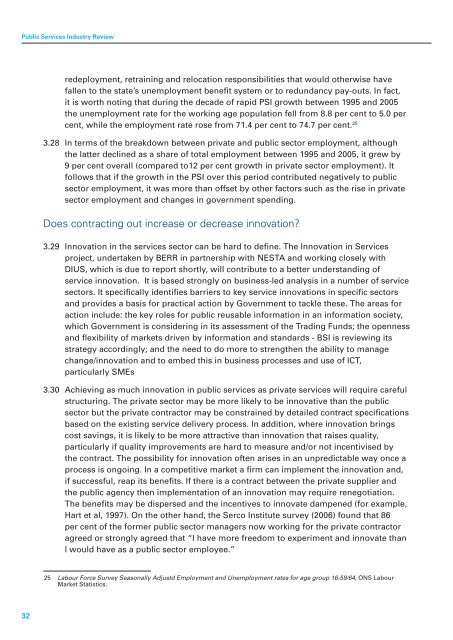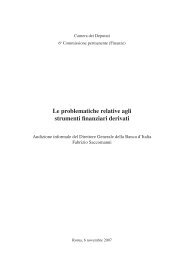Understanding the Public Services Industy
Understanding the Public Services Industy
Understanding the Public Services Industy
Create successful ePaper yourself
Turn your PDF publications into a flip-book with our unique Google optimized e-Paper software.
<strong>Public</strong> <strong>Services</strong> Industry Review<br />
redeployment, retraining and relocation responsibilities that would o<strong>the</strong>rwise have<br />
fallen to <strong>the</strong> state’s unemployment benefit system or to redundancy pay-outs. In fact,<br />
it is worth noting that during <strong>the</strong> decade of rapid PSI growth between 1995 and 2005<br />
<strong>the</strong> unemployment rate for <strong>the</strong> working age population fell from 8.8 per cent to 5.0 per<br />
cent, while <strong>the</strong> employment rate rose from 71.4 per cent to 74.7 per cent. 25<br />
3.28 In terms of <strong>the</strong> breakdown between private and public sector employment, although<br />
<strong>the</strong> latter declined as a share of total employment between 1995 and 2005, it grew by<br />
9 per cent overall (compared to12 per cent growth in private sector employment). It<br />
follows that if <strong>the</strong> growth in <strong>the</strong> PSI over this period contributed negatively to public<br />
sector employment, it was more than offset by o<strong>the</strong>r factors such as <strong>the</strong> rise in private<br />
sector employment and changes in government spending.<br />
Does contracting out increase or decrease innovation?<br />
3.29 Innovation in <strong>the</strong> services sector can be hard to define. The Innovation in <strong>Services</strong><br />
project, undertaken by BERR in partnership with NESTA and working closely with<br />
DIUS, which is due to report shortly, will contribute to a better understanding of<br />
service innovation. It is based strongly on business-led analysis in a number of service<br />
sectors. It specifically identifies barriers to key service innovations in specific sectors<br />
and provides a basis for practical action by Government to tackle <strong>the</strong>se. The areas for<br />
action include: <strong>the</strong> key roles for public reusable information in an information society,<br />
which Government is considering in its assessment of <strong>the</strong> Trading Funds; <strong>the</strong> openness<br />
and flexibility of markets driven by information and standards - BSI is reviewing its<br />
strategy accordingly; and <strong>the</strong> need to do more to streng<strong>the</strong>n <strong>the</strong> ability to manage<br />
change/innovation and to embed this in business processes and use of ICT,<br />
particularly SMEs<br />
3.30 Achieving as much innovation in public services as private services will require careful<br />
structuring. The private sector may be more likely to be innovative than <strong>the</strong> public<br />
sector but <strong>the</strong> private contractor may be constrained by detailed contract specifications<br />
based on <strong>the</strong> existing service delivery process. In addition, where innovation brings<br />
cost savings, it is likely to be more attractive than innovation that raises quality,<br />
particularly if quality improvements are hard to measure and/or not incentivised by<br />
<strong>the</strong> contract. The possibility for innovation often arises in an unpredictable way once a<br />
process is ongoing. In a competitive market a firm can implement <strong>the</strong> innovation and,<br />
if successful, reap its benefits. If <strong>the</strong>re is a contract between <strong>the</strong> private supplier and<br />
<strong>the</strong> public agency <strong>the</strong>n implementation of an innovation may require renegotiation.<br />
The benefits may be dispersed and <strong>the</strong> incentives to innovate dampened (for example,<br />
Hart et al, 1997). On <strong>the</strong> o<strong>the</strong>r hand, <strong>the</strong> Serco Institute survey (2006) found that 86<br />
per cent of <strong>the</strong> former public sector managers now working for <strong>the</strong> private contractor<br />
agreed or strongly agreed that “I have more freedom to experiment and innovate than<br />
I would have as a public sector employee.”<br />
25 Labour Force Survey Seasonally Adjustd Employment and Unemployment rates for age group 16-59/64, ONS Labour<br />
Market Statistics.<br />
32
















